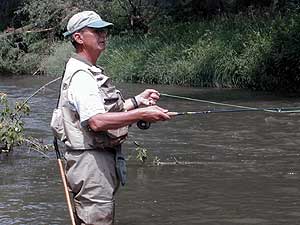|
Audio
Photos
|
July 19, 2005
The Root River in southeastern Minnesota is one of the state's most famous trout streams but it's threatened by pollution as are many waterways around southeast. A major problem is farm runoff which threatens both river life and the health of anglers and boaters. Recently a federal district court judge ruled that a clean up plan designed by the state pollution control agency is inadequate. Now the agency's on deadline to come up with a new plan.
Preston, Minn. — Renowned angler Duke Hust owns a farm near Preston. His property borders the south branch of the Root River and on most days from spring until fall, that's where Hust can be found. He wears waders and walks around the river effortlessly, holding on to his fishing pole.
"Normally when conditions are it's so clear you can see the bottom all the way across," says Hust. "This morning it's somewhere between the color of chocolate milk and steel. The water is quite murky and it's been over a week since the last major rain."
The Root's cold water is ideal for trout. Anglers flock to the river to test their skills. But there's a problem. Farm runoff from nearby fields is muddying the river, coating its rocky bottom with a thick layer of sticky muck. It threatens everything living in the river and it leaves Hust deeply troubled.
The state wants to clean things up, in fact it has to under federal law. The Minnesota Pollution Control Agency developed a plan but it's run into problems and a lawsuit.
The Minnesota Center for Environmental Advocacy filed the suit. The Center's Kris Sigford says the plan was inadequate.
"What we was a case where the pollution control agency developed a clean up plan for these rivers many of which would not meet water quality standards after the imposition of the TMDL," says Sigford.
TMDL stands for total maximum daily load. That's the amount of pollution a body of water can handle and still meet water quality standards.
Sigford says the PCA's proposal fell far short of its goal. She says since it was the state's first comprehensive TMDL project she was concerned about any precedent the plan could set.
So three years ago Sigford's group initiated the litigation that led to last month's court ruling. And now the state pollution control agency has until mid-September to adjust its plan. If it fails, the federal Environmental Protection Agency takes over.
Lee Ganske's a hydrologist with the state Pollution Control Agency. He's been working on the study for years. Ganske cautions that the TMDL study is basically a numerical analysis. He says it doesn't translate in to specific clean up action.
He says most big industrial polluters have been taken care of. But that actually complicates things because now they have to trace hundreds of thousands of smaller polluters. On top of that the weather and even the seasons can have an impact on pollution levels.
"A rainfall that occurs in the spring might have a different effect than what happens in August when there are crops growing on the fields," explains Ganske. "So it's really a rather complex problem of assessing the link between the sources and water quality in this non-point world."
Ganske predicts if the federal Environmental Protection Agency is forced to take over the study it will produce a very similar report from the state's version. He says it might take another round of court hearings to resolve the issue.




